Soviet anti-tank grenade launchers. Part 1
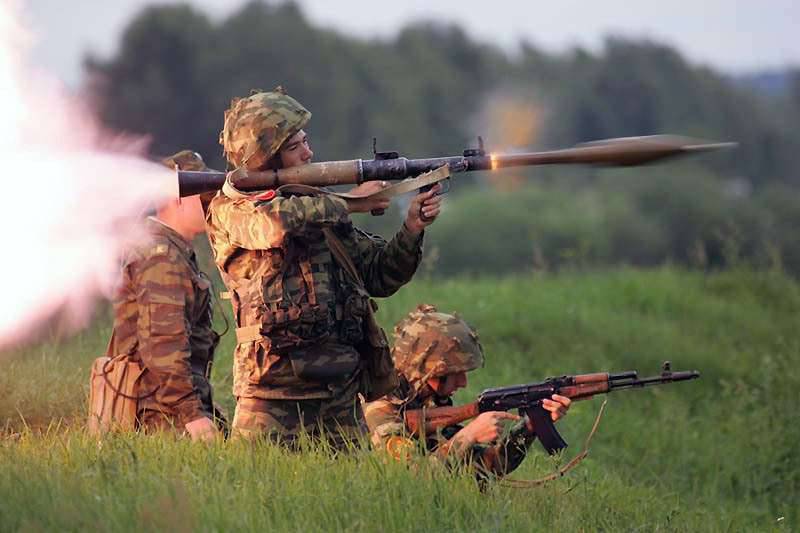
During the Great Patriotic War, the main anti-tank weapons of the Red Army infantrymen were anti-tank hand grenades, incendiary bottles KS and anti-tank guns. At the initial stage of the war, as an improvised means of fighting armored vehicles, bundles of fragmentation grenades and fuel bottles were used, equipped with improvised igniters (more details here: Anti-tank weapons of the Soviet infantry during the war).
To use these anti-tank weapons, it was necessary to approach the enemy tank throwing distance, which was associated with great risk. Unfortunately, nothing similar to the German Panzerfaust or the American Bazooka was received by our infantry during the war.
In 30 in the USSR under the leadership of L.V. Kurchevsky, work was carried out to create recoilless, or as they said then, dynamo-reactive systems. Due to the adventurous traits of the designer’s character and the short-sightedness of his high-ranking patrons, they used dynamo-reactive cannons with a loaded rifled barrel to replace the entire field artillery. Naturally, this undertaking was doomed to failure, for which Kurchevsky eventually lost his life. As subsequent events showed, specialized anti-tank smooth-bore guns were much more promising, firing a feathered cumulative projectile at a distance of several hundred meters and light hand-held rocket launchers served by one fighter.
The development of such weapons in the USSR, it was conducted in wartime, in the 1944, a reusable hand-held anti-tank grenade launcher RPG-1, originally designated as LPG-44, entered the tests. This weapon was created at the Research and Development Range of the small arms and mortar armament of the GRAU under the guidance of the GP. Lominsky.
For its time, the RPG-1 had quite acceptable combat characteristics. The range of a direct shot of an 70-mm over-caliber cumulative muzzle-loading grenade reached 50 meters. Grenade with weight 1,6 kg normal punched 150 mm homogeneous armor. Its stabilization in flight was carried out by a rigid feather stabilizer. Black powder was used as a propellant charge, which gave a thick cloud of clearly visible white smoke when fired.
With a caliber of 30 mm and a length of about 1 meter, an unloaded grenade launcher weighed a little more than 2 kg and had a fairly simple design. On the trunk of the RPG-1 mounted hammer-type firing mechanism, aiming bar and wooden thermal protection lining. The top of the grenade served as a front sight when aiming.
On tests, the weapon showed very encouraging results. Without waiting for the end of field testing, the preparation of mass production and the production of pilot batches of grenade launchers and grenades for large-scale military tests in the army in the army began. But because of the unreliable operation of the fuses of a cumulative grenade and the unstable characteristics of the propellant charge, the weapons were greatly delayed. As a result, due to the end of hostilities, obsolescence, and the development of more promising RPG-1 models, it was never adopted.
In 1947, a more successful model entered into service - the RPG-2. The grenade launcher was created under the direction of A.V. Smolyakova in the Design Bureau GSKB-30 of the Ministry of Agricultural Engineering. Having a similar device, the RPG-2 was significantly superior to the RPG-1 in combat performance. The range of direct shot RPG-2 increased to 100 meters. An 82-mm cumulative PG-2 1,85 grenade weighing 200 kg could pierce 1200 mm armor, which was then enough to fight medium and heavy tanks. Undermining the charge after hitting the target was carried out by a bottom fuse. The grenade launcher had a length - 4,5 mm and weight - XNUMX kg.

The same smoky gunpowder in a cardboard sleeve served as a propellant charge, which was attached to a cumulative grenade just before the shot with the help of a threaded connection. The stabilization of the PG-2 on the trajectory was carried out by six flexible steel feathers, folded around the tube and unfolding after the departure of the grenade from the barrel.
The design of the RPG-2 was quite simple. 40-mm steel seamless pipe with wooden lining in the middle part was used as a barrel to protect against burns when fired and more comfortable to use the weapon in low temperatures. At the RPG-2 mounted mechanical sight, designed for a distance of 150 meters. The trigger type trigger mechanism with a striker mechanism ensured the reliability and convenience of firing a shot.
Mass deliveries of the RPG-2 to the troops began in 1949. Being a fairly simple, inexpensive and effective weapon for its time, it became widespread and was used in many armed conflicts of the 50-80's. In addition to its direct purpose - the fight with armored vehicles - RPG-2 could destroy firing points and light fortifications. Quite often it was used against manpower, although the fragmentation effect of the PG-2 grenade left much to be desired.
RPG-2 except the USSR was produced in Egypt, in Vietnam, in the People's Republic of China, the DPRK, Poland and Romania. In Poland and the PRC for the RPG-2, their own anti-tank shots were created, while in the DPRK they developed and adopted a fragmentation grenade. In a number of Asian and African countries, the RPG-2 grenade launcher is still in service. In the design of the RPG-2 when creating were laid successful technical solutions, which later became the base when creating more advanced grenade launchers.
At the same time, the RPG-2, created by wartime technology, had a number of drawbacks. A significant disadvantage was the use of black powder in the propellant charge, which had a low energy potential and unmasking thick white smoke. In conditions of high humidity, the cardboard sleeve swelled, which made loading impossible, the powder itself when becoming damp became unsuitable for firing. The low initial speed of the grenade - 84 m / s made it very susceptible to wind drift on the trajectory. To get even with an average side wind in a tank at a distance of 100 meters was a very difficult task.
In addition to a hand-held anti-tank grenade launcher with an effective range of several tens of meters, the military also wanted to have a long-range, rapid-fire and accurate infantry means of fighting tanks, served by a crew of 2-3 people. In 1950, the anti-tank defense complex was adopted as part of the LNG-82 82-mm easel anti-tank grenade launcher PG-82 anti-tank grenade.
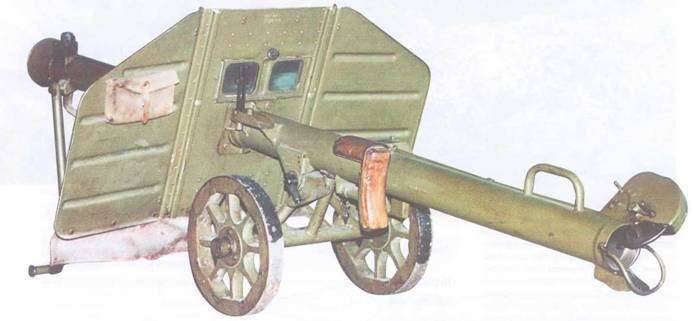
The design of the heavy-duty grenade launcher began as early as 1942 in the special design bureau No. 36 of the USSR People's Commissariat for Petroleum Industry under the leadership of A.P. Ostrovsky and chief designer N.G. Grigorian, at the end of 40-x, PP was connected to this work. Shumilov. Initially it was planned to use a turbojet grenade, stabilization of which was carried out by rotation. However, since the cumulative munition rotates at high speed, the cumulative jet “sprays”, which greatly reduces armor penetration, this method of stabilization was later abandoned.
In contrast to Kurchevsky's recoilless pipes, a thin-walled barrel without grooves was used in the LNG-82. The barrel consisted of two parts: muzzle and breech, connected by a coupling. The barrel of the grenade launcher was mounted on a machine with a wheel course and a folding shield. On the trunk fastened shoulder support, sight and self-firing firing mechanism. In addition to protecting the calculation from bullets and fragments, the shield protected the calculation from the action of powder gases. When fired, the glazed observation windows in the shield were automatically overlapped with protective metal flaps. The LNG-82 calculation consisted of three people: the gunner, the loader and the ammunition carrier. The range of the LNG-82 stand-off grenade launcher reached 200 meters, and the firing rate was 6 rounds per minute. The mass of the LNG-82 grenade launcher was 32 kg, which was even less than the weight of the SG-43 machine gun on the wheel machine.
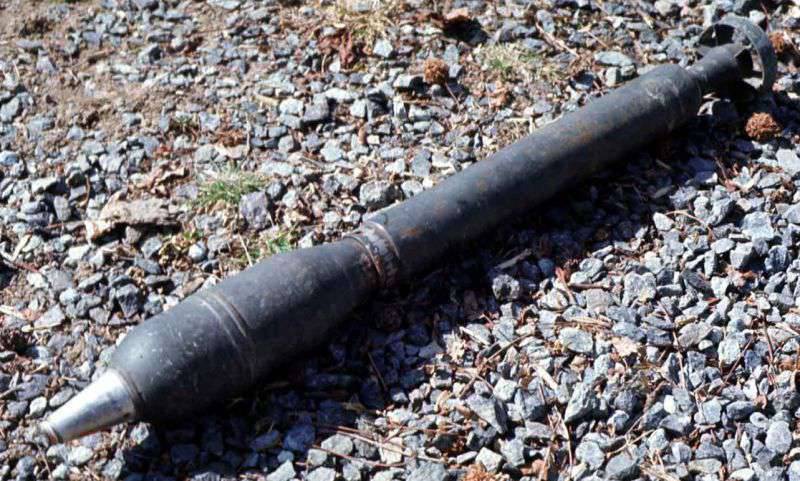
In the cumulative PG-82 grenade, a jet engine was used on smokeless nitroglycerin powder. The stability of the grenade after the shot was provided by a stabilizer of six hard feathers. Grenade PG-82 with weight - 4,5 kg normal pierced 175 mm homogeneous armor.
In the middle of the 50's, the LNG-82 grenade launcher was upgraded, with the aim of improving the working conditions of the calculation, the sights and shoulder rest were changed. To destroy enemy personnel and destroy light field-type fortifications, the OG-82 fragmentation grenade was inserted into the ammunition. Expansion of the range of ammunition significantly improved the combat capabilities of the grenade launcher, especially in defense. With the range of the aimed shot by the grenade of the OG-82 - 700 m, it gave a radius of a continuous defeat - 12 m.
In the Soviet army, the LNG-82 belonged to the anti-tank infantry of the battalion link, where they were used until the second half of the 60-s. Later they were replaced by more advanced models of grenade launchers and anti-tank guided missiles.
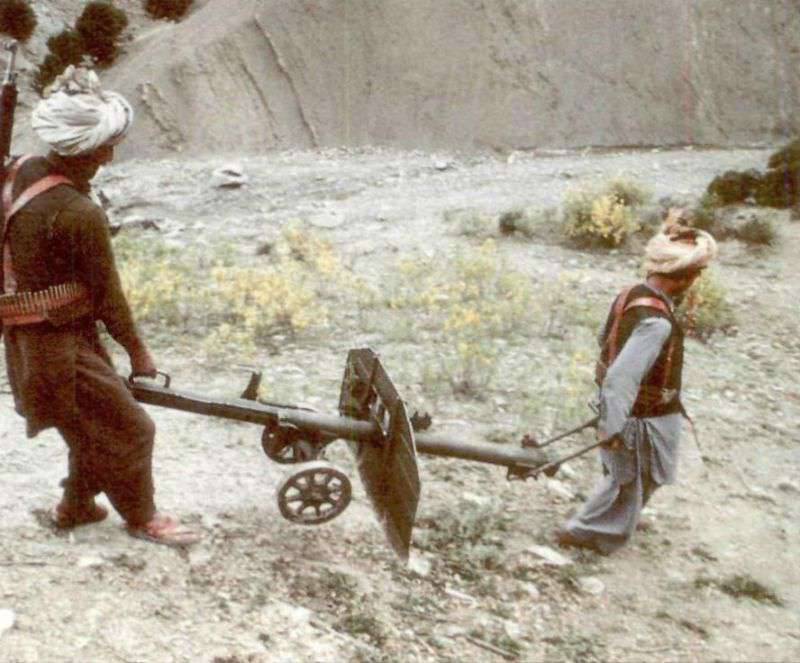
LNG-82 was delivered to the allies of the USSR under the Warsaw Pact and to the countries of the “third world”. This machine gun grenade was actively used during the hostilities in Afghanistan. At the moment, it is hopelessly outdated and almost universally decommissioned.
In the second half of 50-x in GSKB-47 (now FSUE "GNPP Basalt") was created RPG-4, the design of which in many respects repeated RPG-2. Using the successful technical solutions of the previous model, the developers tried to get rid of the shortcomings of the RPG-2 and increase the effective firing range. For this purpose, the diameter of the grenade launcher increased to 45 mm, and a larger-diameter charging chamber was introduced, which significantly added the amount of propellant charge. Direct shot range increased to 140 meters, and sighting range of shooting up to 300 meters. In this regard, changes were made to the sights. At the breech breech in order to disperse the jet stream was mounted socket.
The anti-tank grenade compared to PG-2 has undergone minor changes, its caliber remained the same, but due to the change in the focal length and the shape of the cumulative funnel, armor penetration increased to 220 mm.
The RPG-4 anti-tank grenade launcher in 1961 successfully passed ground tests. But due to the appearance of more promising models, significantly exceeding in firing range and armor penetration, the RPG-4 was not adopted.
In the same year 1961, after a complex of comprehensive tests for service, the RPG-7 entered, which later became a real “bestseller” and a grenade launcher “of all times and peoples”. When it was created, the designers of GSKB-47 took into account the experience of the combat use of the domestic RPG-2 and foreign models. Specialists from the Tula TsKIB SOO and the Kovrov Mechanical Plant also took part in the development of the RPG-7. Grenade launcher shot PG-7В developed under the direction of VK. Firulina.
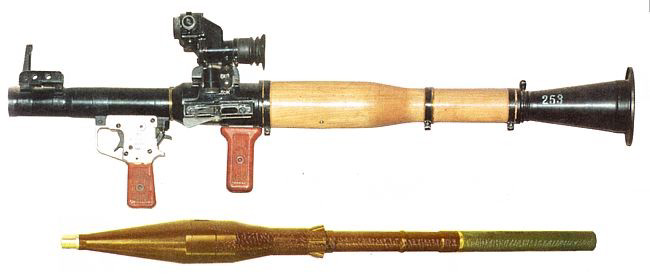
The design of the RPG-7 was based on successful technical solutions of the RPG-2 with a reusable starting device and a shot with the above-caliber warhead. RPG-7 has a special charging chamber in the middle of the barrel - this allows you to more efficiently use the energy of the propellant charge. To disperse the jet during firing and the elimination of recoil is the socket in the breech breech. Unlike PG-2, where only the starting powder charge is used, the RPG-7 grenade launcher used PG-7В shots with a jet engine - this not only increased the direct shot range to 300 meters, but also significantly improved the accuracy. The speed of the PG-7В flight at the moment of departure from the trunk is 120 m / s, at the end of the active segment it increases to 300 m / s. A unique feature of the PG-7B anti-tank grenade was the use of a piezoelectric fuse.
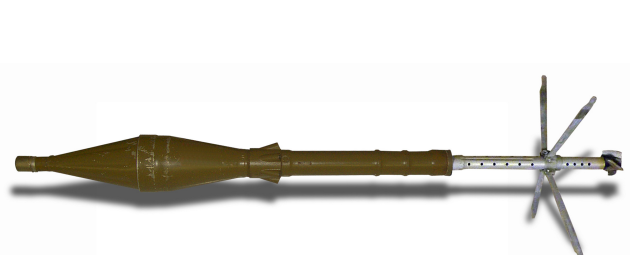
To stabilize PG-7B, four drop blades are used. To increase the accuracy of fire and compensate for errors in the manufacture, the grenade rotates at a speed of several tens of revolutions per second.
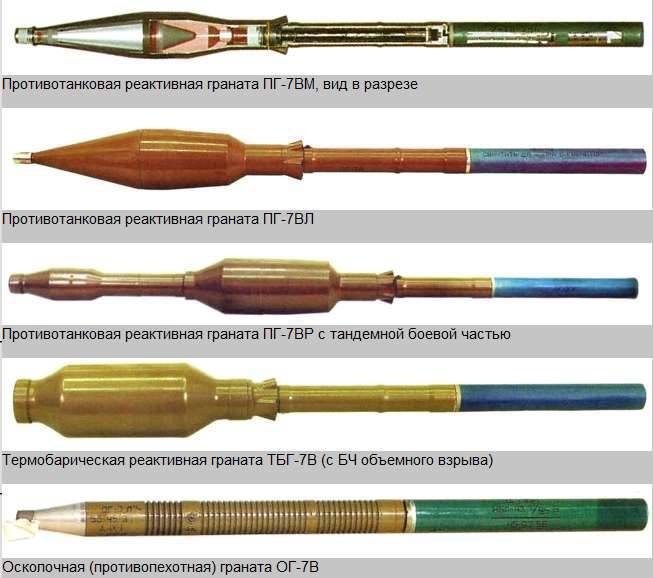
Depending on the modification, the anti-tank grenades for the RPG-7 are 70-105 mm caliber and 260-700 mm armor penetration. In the 80-90 year, the Basalt specialists for the RPG-7 created thermobaric and fragmentation ammunition, which seriously expanded the flexibility and combat effectiveness of the grenade launcher.
The RPG-7 became the first Soviet anti-tank grenade launcher, where an optical sight was used. It is used to observe and guide the grenade launcher at the target, taking into account the amendments. The presence of the PGO-7 sight (or its modifications of the PGO-7В, PGO-7В-2, PGO-7В-3, etc.) scales of the side and rangefinder grid improves the accuracy of shooting and allows you to effectively introduce corrections taking into account the speed of movement targets, range and ballistics of different types of jet grenades.
An optical sight with an increase in the target 2,7 creep is an optical system of prisms and lenses in a sealed metal case, to prevent fogging filled with dry nitrogen. To improve visibility in difficult weather conditions, the sight is equipped with a set of light filters. A rubber cap is put on the lens to protect it from contamination and prevent unmasking glare. In the dark, the backlight scale is used. On the 2001 of the RPG-7B2 and RPG-7D3 modifications, together with an optical sight, a mechanical sight is set for firing thermobaric and fragmentation grenades. In addition to the standard optical sight on the RPG-7, it is possible to use night sights. A grenade launcher with a night sight has a mechanism that disables the sight at the time of the shot, to prevent it from being flashed when the rocket grenade is fired from the barrel. For shooting with RPG-7 with a night sight it is recommended to use a foldable detachable bipod.
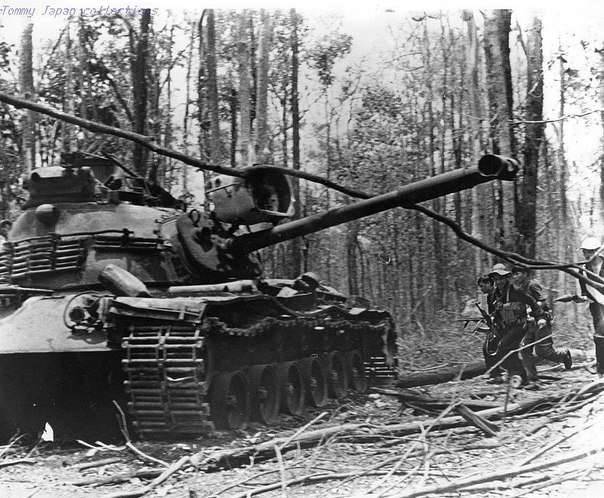
The combat debut of the RPG-7 took place at the end of the 60-s in the jungles of Southeast Asia. With the help of Soviet grenade launchers, Vietnamese partisans not only fought with American armored vehicles, but also delivered effective strikes at transport convoys and fortified positions. It also turned out that an anti-tank grenade launcher can be an effective means against low-flying helicopters. There have been many instances when pilots of American jet combat aircraft stopped performing combat missions or carried out unarmed bombs dropping by taking a shot from the RPG-7 to their side for a MANPADS missile.
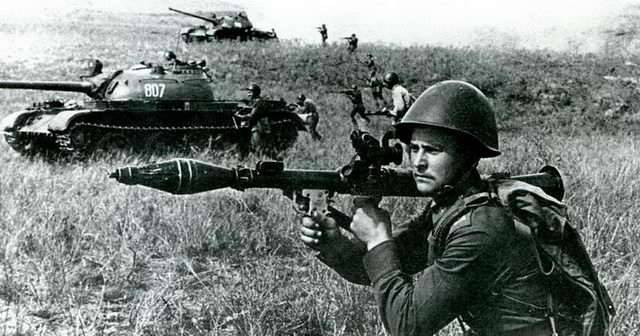
In the Soviet states, there was a grenade launcher in every motorized infantry unit. RPG-7 for decades was the main type of anti-tank grenade launcher in the Soviet Army. With a weight without grenades - 6,3 kg and a length of 950 mm grenade launcher could hit all modern tanks. Especially for the airborne troops, the RPG-7D was developed, the design of which allowed the grenade launcher to be disassembled and folded in preparation for the landing.
Despite the appearance of new grenade launchers in 80-90-s in our country, the creation of increased efficiency shots for the RPG-7 allows it to fight all types of armor and remain in service with the Russian army. According to the criterion of "cost-effectiveness" and the weight and size characteristics of the RPG-7, it still remains unsurpassed among modern reusable grenade launchers. In 1988, the reactive anti-tank grenade PG-7BP "Resume" with a tandem combat unit, designed to combat tanks equipped with dynamic protection, entered service. Unfortunately, not many of these modern-day ammunition have been supplied to the troops, the main types of grenade launchers for RPG-7 are currently PG-7BC and PG-7 BAT - with armor penetration 400-500 mm.
RPG-7 grenade launchers were widely exported and participated in many large and small wars. It is no coincidence that American films RPG-7, along with Kalashnikov assault rifles, appear as weapons of the “bad guys.” In Iraq and Afghanistan, most of the casualties of the anti-terrorist coalition’s armored vehicles fell on the fire of the RPG-7.
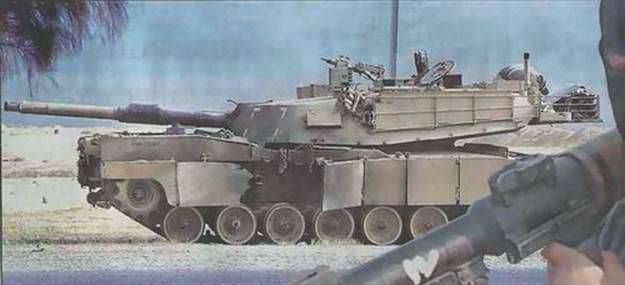
In different countries, attempts were made to self-upgrade the RPG-7, its sighting devices and grenade launchers. At the arms exhibitions, grenade launchers with laser designators and collimator sights, as well as regular cumulative grenades equipped with fragmentation shirts were repeatedly demonstrated. However, laser and collimator sights with an unconditional improvement in ease of aiming can be effectively used only at a distance of a direct shot, and weighting of anti-tank rocket grenades with fragmentation shirts leads to a significant reduction in the firing range. From the same series, homemade attempts to increase the fragmentation and high-explosive effect of PG-7 by winding steel wire or tape on them and attaching trotyl sticks. Naturally, such a "self-made modernization" significantly reduces the range and accuracy of the shot and often represents a danger to the grenade launcher himself.
RPG-7 produced or produced: in Bulgaria, Georgia, Egypt, Iraq, Iran, China, the DPRK, Pakistan, Romania and the United States. In Iran and the United States, modifications of grenade launchers and shots to them have been created, significantly different from the Soviet prototypes.
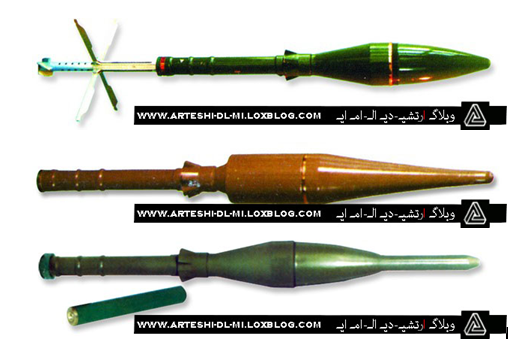
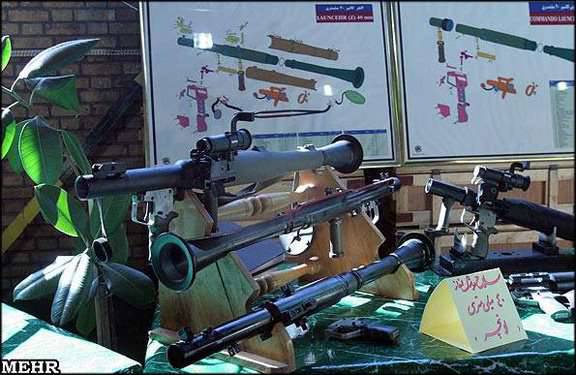
An Iranian grenade launcher called Fath is produced in two versions, Normal and Commando (a shortened version for special forces).

In the US, private gun companies offer several versions of grenade launchers based on the RPG-7. Of greatest interest are products of the company Airtronic USA. The grenade launcher known as the Airtronic USA RPG-7, in addition to the simplified mechanical sighting devices, is equipped with Picatinnyrail guides, which makes it possible to install a wide range of optical and night sights. In addition, the grenade launcher Airtronic USA RPG-7 has a plastic butt, which is a rather controversial decision.

Another development company - Airtronic USA Mk.777 - was perhaps the easiest among the well-known modifications RPG-7. This option has a carbon fiber barrel with a thin-walled steel liner, which made it possible to reduce the mass of an unloaded weapon almost twice while retaining all its combat characteristics. Grenade launchers made in the USA allow firing of all the ammunition available for the RPG-7.
Having become one of the most common and effective models of light anti-tank weapons, RPG-7 is used in armies of more than 50 states. Taking into account foreign copies, the number of RPG-7 produced exceeds 1 million copies.
In 1963, the mass production of the 73-mm heavy machine-based anti-tank grenade launcher, the Spear-LNG-9, began. He, as well as the RPG-7 was created in GSKB-47 (now FSUE "Basalt"). Its appearance was due to the desire to increase the range of effective fire of anti-tank weapons of motorized rifle units. Although the LNG-9, being a rather heavy weapon, did not deserve such fame as the RPG-7 - this machine-based grenade launcher, which replaced the LNG-82, was also widely used and participated in many armed conflicts. In fact, the LNG-9 was a lightweight breech-loading recoilless rifle on a tripod machine. With a barrel length of 670 mm, the effective range of the LNG-9 for tanks is 700 meters, which is more than twice that of the RPG-7. Rate of fire to 6 rds / min.
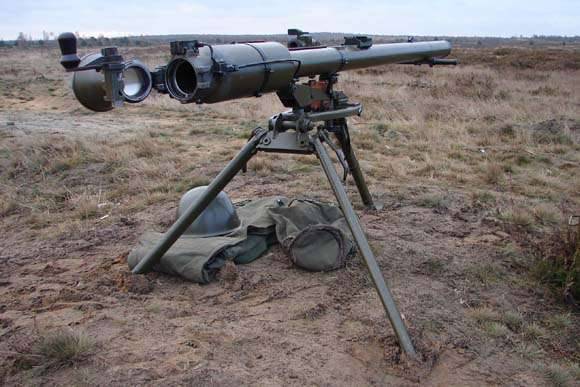
73-mm active-reactive grenade PG-9 after the completion of the jet engine accelerated to 700 m / s. Compared with PG-7, the PG-9 anti-tank grenade had much better accuracy and was less susceptible to the effects of wind on the trajectory. The anti-tank gauge cumulative PG-9 grenade is equipped with an instantaneous piezoelectric fuse. In the tail section there is a jet engine with a six-pronged stabilizer and tracers after a shot. The starting charge consists of a sample of nitroglycerin powder in a fabric cap, placed in a metal perforated tube with a diaphragm, of an igniter charge with an electrical fuse. Penetration of a cumulative grenade, depending on the modification - 300-400 mm.
The LNG-9 grenade launcher is equipped with the 4,2 PGO-9 multiple optical sight. The tripod allows you to fire with a maximum elevation angle of + 25 °, the horizontal pickup angle is + -15 °. The design of the machine allows you to adjust the height of the line of fire ranging from 390 - 700 mm from the ground. With a total length in the combat position 1055 mm and weight 48 kg, the grenade launcher can be transported over short distances by the calculation of four people. For transportation over long distances, the grenade disassembled disassembled into separate units.
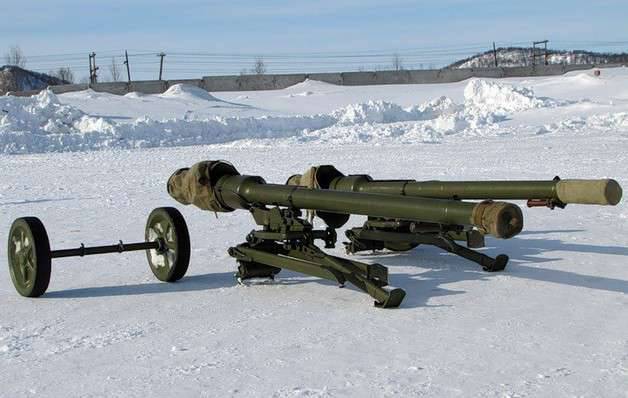
In the 60-70, the heavy-duty grenade launcher was repeatedly upgraded; shots with enhanced armor penetration and a direct shot range increased to 9 meters were injected into the LNG-900M ammunition load. The fragmented grenade OG-9 was adopted to the modernized grenade launcher. Fragment shot does not have a jet engine, but only the starting powder charge. The maximum firing range of fragmentation grenades is 4500 meters. An updated version of the LNG-9M grenade launcher received a new sighting device - PGOK-9. It consists of two separate sights: one for shooting direct-fire cumulative grenades, the second for working with a frag grenade. Especially for the Airborne Forces, the SPG-9D machine-mounted grenade launcher was developed - with a wheel-tripod machine. Modifications - LNG-9H, LNG-9DN, LNG-9MN, LNG-9DMN - were equipped with a PGN-9 night sight.
The design and dimensions of the LNG-9 grenade launchers allows them to be mounted on various vehicles and light armored vehicles. This quality turned out to be especially popular in the airborne troops and in mobile reconnaissance and shock units. Self-propelled grenade launchers, as a rule, were used not to combat armored vehicles, but to destroy manpower with fragmentation grenades and to destroy light shelters.
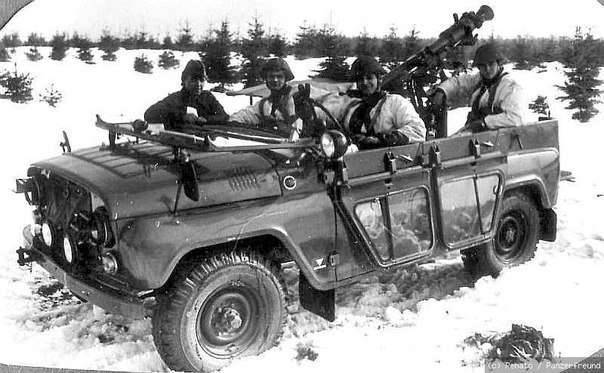
In addition to the USSR, LNG-9 grenade launchers and ammunition for them were licensed in a number of countries of the former Eastern bloc. This weapon has proved itself well in many local wars. Relatively light weight and good accuracy allows you to effectively apply LNG-9 in street battles. Despite a decent age and modest by modern standards, the armor penetration performance of the LNG-9 grenade launchers regularly get into the lenses of cameras in “hot spots”. They can often be seen in reports shot in the south-east of Ukraine and in Syria.
In 1970, the Airborne Forces entered the TKB under the leadership of I.Ye. Rogozin hand-held anti-tank grenade launcher RPG-16 "Strike". Unlike the RPG-7, it used the 58,3 - mm caliber cumulative PG-16 grenade. Due to the high initial and marching speed of the anti-tank grenade, it was possible to significantly increase the range of the direct shot and the accuracy of shooting.
With a direct shot 520 shotgun range, PG-16 grenade could penetrate 300 mm homogeneous armor. Aiming at the target is carried out using the built-in mechanical sight or the removable 2,7-multiple optical sight PGO-16. Compared with the RPG-7, the RPG-16 landing grenade launcher turned out to be heavier and more cumbersome. Its mass was - 10,3 kg, and the length of the assembled - 1104 mm.
As you know - “disadvantages - the continuation of the merits. This fully applies to the RPG-16 anti-tank grenade launcher. At the time of adoption of the RPG-16 into service, it was not inferior to the RPN-7 in armor penetration, significantly exceeding its accuracy and range of the shot. However, after 10 years, after the appearance of the Abrams, Challenger and Leopard-2 tanks, the characteristics of armor penetration ceased to suit the military. For the RPG-7, this indicator grew with the increase in the caliber of the head of the grenade, but in the RPG-16, using a caliber grenade, this direction of improving the fighting qualities was impossible. As a result, the RPG-7D again began to enter the Airborne Forces with new anti-tank grenades.
Due to their good accuracy and range of fire, RPG-16 grenade launchers were popular among the Soviet special forces in Afghanistan. Naturally, there they were not used against tanks, the sniper's rocket-launcher shots destroyed the manpower and firing points of the Afghan insurgents. Quite limitedly, RPG-16 was used in armed conflicts in the post-Soviet space. Currently, RPG-16 grenade launchers in the combat units of the Russian armed forces are not being used, although they have not been officially removed from service.
To be continued ...
Based on:
http://russianguns.ru
http://ryadovoy.ru/militarizm/antiarmored/grenade_RPG.htm


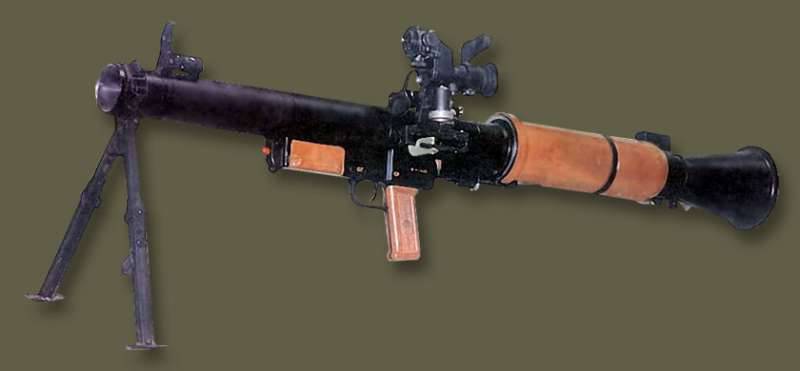
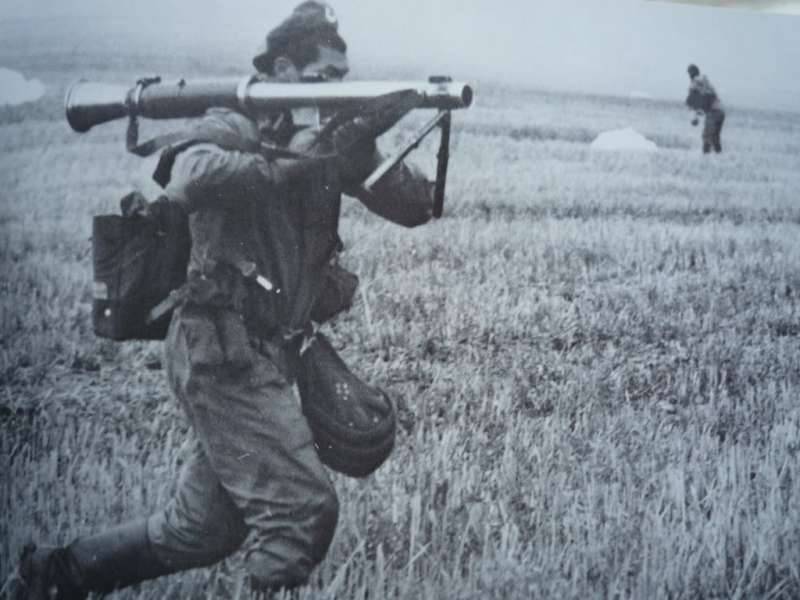
Information